Storytelling through collectibles offers a unique lens into personal narratives and historical contexts, as each item embodies individual experiences and cultural significance. These tangible artifacts not only evoke nostalgia but also forge emotional connections, linking collectors to their memories and the broader tapestry of history. By exploring the stories behind these treasures, we gain insights into the values and events that have shaped societies over time.
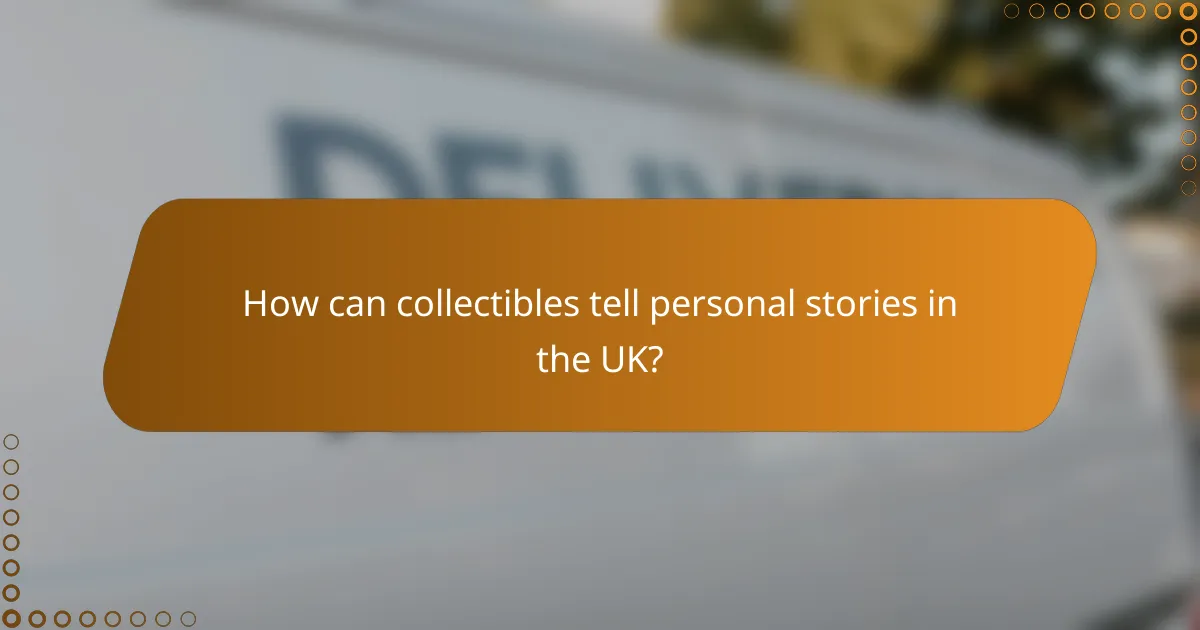
How can collectibles tell personal stories in the UK?
Collectibles in the UK can serve as powerful vessels for personal stories, reflecting individual experiences and historical contexts. Each item often carries emotional weight, connecting the collector to memories, family histories, and cultural narratives.
Emotional connections through family heirlooms
Family heirlooms often embody deep emotional connections, serving as tangible links to past generations. Items like antique jewelry, furniture, or photographs can evoke memories and stories that define family legacies.
When sharing these heirlooms, consider the stories behind them. For instance, a grandfather’s pocket watch may symbolize time spent together, while a grandmother’s quilt could represent family gatherings. These narratives enhance the sentimental value of the collectibles.
Personal narratives in vintage toys
Vintage toys can encapsulate personal narratives, reflecting childhood experiences and cultural shifts. Items like action figures or dolls often remind collectors of their youth, sparking nostalgia and personal stories tied to specific moments in their lives.
For example, a collector might cherish a particular toy from the 1980s that reminds them of family holidays or friendships. Sharing these stories can create connections with others who have similar experiences, fostering a sense of community among collectors.
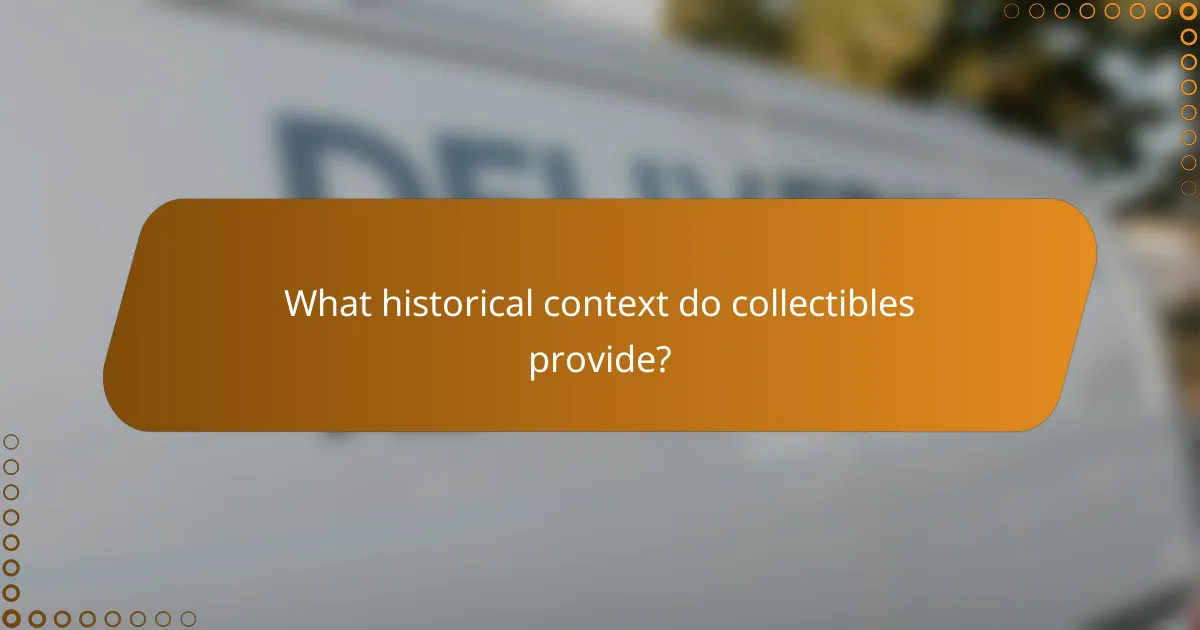
What historical context do collectibles provide?
Collectibles serve as tangible links to the past, offering insights into cultural, social, and economic conditions of different eras. They reflect the values, interests, and historical events that shaped societies, allowing collectors to explore personal narratives and broader historical contexts.
Collectibles reflecting British cultural history
British collectibles, such as coins, toys, and memorabilia, encapsulate significant moments in the nation’s cultural evolution. Items like vintage tea sets or classic board games can reveal social customs and leisure activities from various periods. Additionally, collectibles often highlight shifts in technology and design, showcasing how British craftsmanship has evolved over time.
For instance, collecting Royal memorabilia can connect enthusiasts to the monarchy’s influence on British identity and national pride. Each item tells a story, whether it’s a commemorative plate from a royal wedding or a vintage poster from a historic event.
Historical significance of stamps in the UK
Stamps in the UK are not just postal tools; they are rich historical artifacts that document the nation’s evolution. The introduction of the Penny Black in 1840 marked a revolutionary change in postal services and is often seen as a symbol of accessibility and communication. Collecting stamps allows enthusiasts to trace the development of British society, politics, and art through the imagery and themes depicted.
Stamp collecting, or philately, can provide insights into important historical events, such as wars, royal celebrations, and cultural milestones. Each stamp can represent a moment in time, reflecting the values and priorities of the society that issued it, making them invaluable for both collectors and historians alike.

How do collectibles foster emotional connections?
Collectibles create emotional connections by serving as tangible reminders of personal experiences, historical moments, or cultural significance. These items often evoke nostalgia and foster a sense of belonging, linking individuals to their past and to others who share similar interests.
Sentimental value of memorabilia
Memorabilia often carries deep sentimental value, as it represents cherished memories and milestones. For instance, a vintage toy from childhood or a concert ticket from a memorable event can evoke powerful emotions and stories. Collectors frequently find that these items serve as conversation starters, allowing them to share personal narratives and connect with others on a deeper level.
The emotional weight of memorabilia can vary significantly based on individual experiences. Items that hold personal significance, such as family heirlooms or gifts from loved ones, tend to be valued more highly than generic collectibles. This personal attachment enhances the emotional connection and makes the item irreplaceable.
Community bonding through collectible events
Collectible events, such as conventions, trade shows, or local meet-ups, provide opportunities for enthusiasts to connect and share their passions. These gatherings foster a sense of community, as collectors bond over shared interests and experiences. Engaging with others who appreciate similar items can strengthen relationships and create lasting friendships.
Participating in these events can also enhance the emotional connection to collectibles. For example, attending a comic book convention allows fans to meet artists, attend panels, and engage in discussions about their favorite series. These shared experiences deepen the appreciation for the collectibles and the stories behind them, reinforcing the emotional ties within the community.
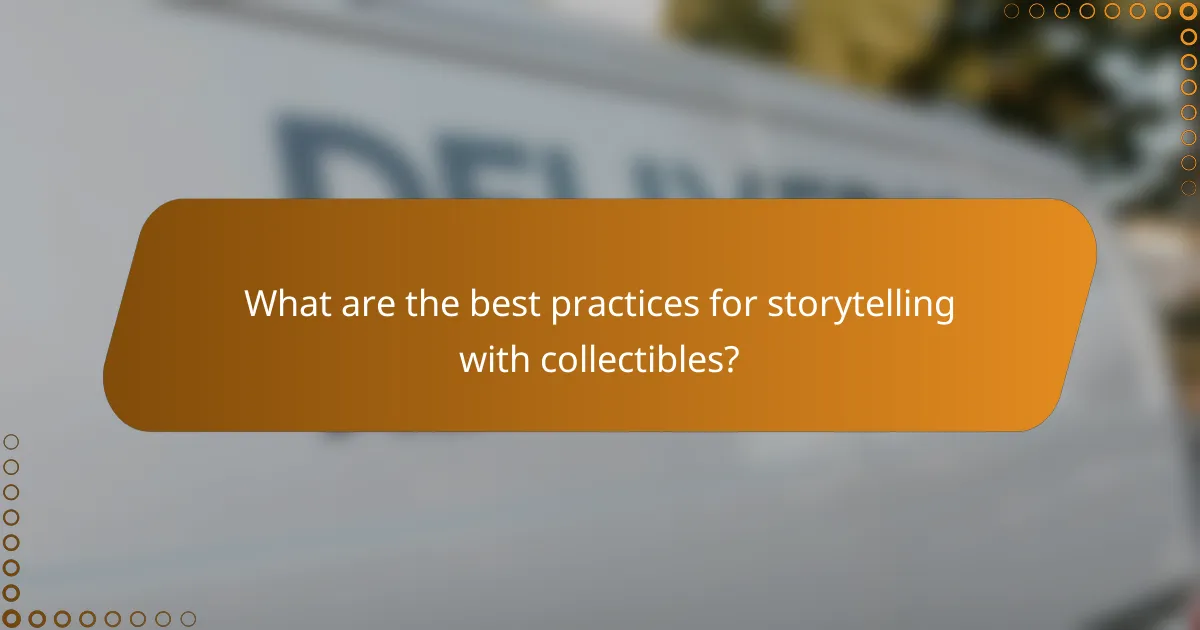
What are the best practices for storytelling with collectibles?
Effective storytelling with collectibles involves curating meaningful items and documenting their unique narratives. This approach not only enhances personal connections but also provides historical context that enriches the overall experience.
Curating a personal collection
Curating a personal collection requires thoughtful selection of items that resonate with your interests or experiences. Focus on themes that reflect your identity, such as childhood memories, travel experiences, or family heritage.
Consider setting a budget for your collection to avoid overspending. Aim for a balance between rare finds and affordable pieces, ensuring that each item contributes to the overall narrative you wish to convey.
Documenting stories behind each item
Documenting the stories behind each collectible is crucial for preserving their significance. Write down where and when you acquired each item, as well as any personal anecdotes associated with it.
Utilize photographs, letters, or other memorabilia to create a richer context. This documentation can be organized in a scrapbook or digital format, allowing for easy sharing with family and friends.

How to choose collectibles that resonate?
To choose collectibles that resonate, focus on items that reflect your personal interests and hold emotional significance. Consider how these pieces connect to your life experiences or historical narratives that inspire you.
Identifying personal interests and passions
Start by reflecting on your hobbies, favorite themes, or historical periods that intrigue you. Whether it’s vintage toys, rare coins, or art pieces, your passion will guide your collection choices and enhance your enjoyment.
Make a list of topics or items that excite you, and prioritize those that evoke strong memories or emotions. This personal connection will make your collection more meaningful and enjoyable over time.
Researching market trends in collectibles
Stay informed about current market trends to understand which collectibles are gaining popularity. Follow industry news, join collector groups, and explore online marketplaces to gauge demand and pricing.
Consider using resources like price guides or auction results to assess the value of potential collectibles. This knowledge will help you make informed decisions and avoid overpaying for items that may not hold their value.
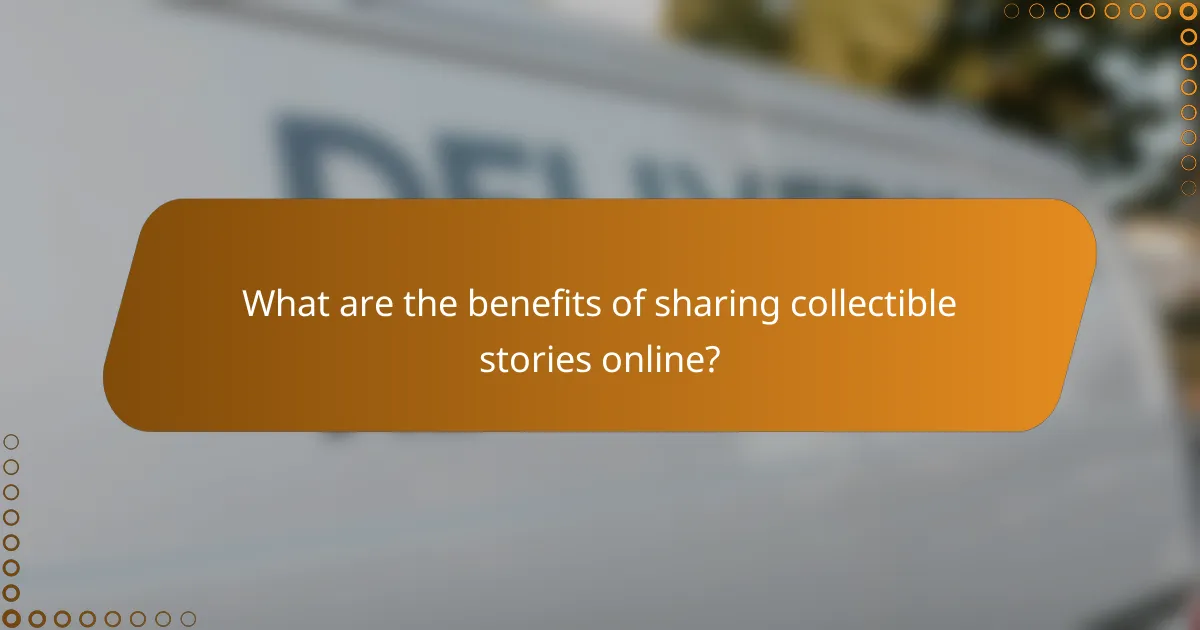
What are the benefits of sharing collectible stories online?
Sharing collectible stories online fosters connections among collectors and enhances the appreciation of personal narratives. It allows individuals to showcase their collections while engaging with a broader audience, creating a shared experience around the items they cherish.
Building an online community
Creating an online community around collectibles encourages interaction and collaboration among enthusiasts. Platforms like social media, forums, and dedicated collectible websites allow users to share their stories, ask questions, and provide support to one another.
Engaging with others who share similar interests can lead to friendships and partnerships, enriching the collecting experience. Regularly participating in discussions and sharing insights can help strengthen these connections.
Enhancing visibility for personal collections
Sharing stories about personal collections online significantly increases their visibility. By posting images and narratives on platforms like Instagram or specialized collectible sites, collectors can reach a global audience, attracting potential buyers or fellow enthusiasts.
To maximize visibility, consider using relevant hashtags and engaging with other collectors’ posts. This not only showcases your collection but also invites feedback and interaction, further enhancing your online presence.
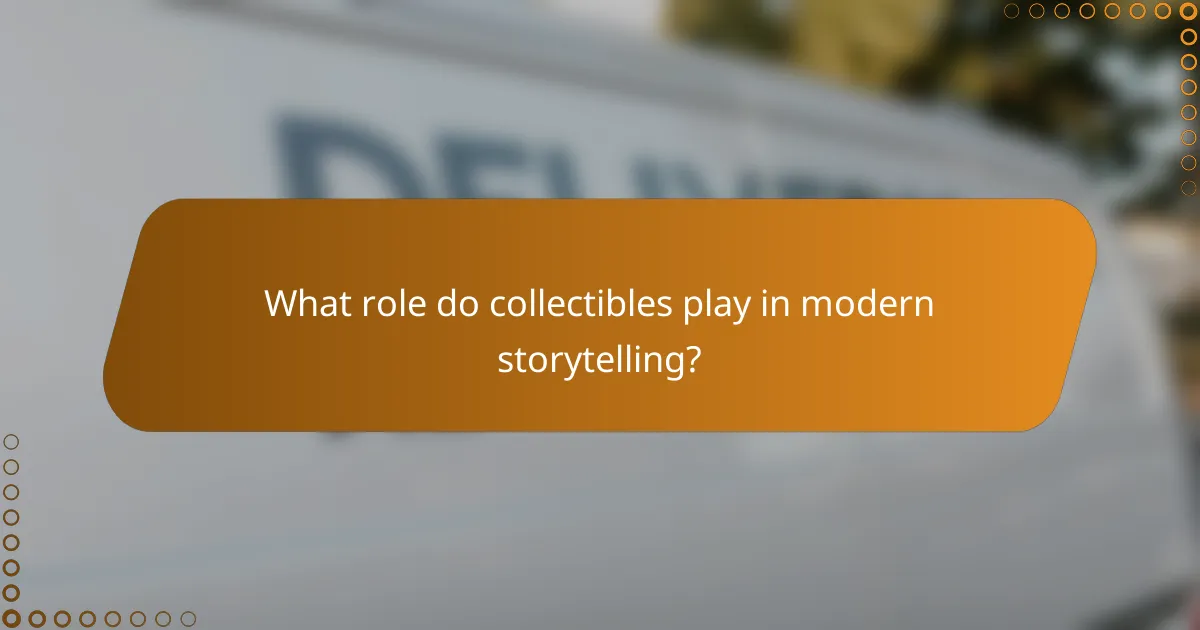
What role do collectibles play in modern storytelling?
Collectibles serve as powerful tools in modern storytelling by providing tangible connections to personal narratives and historical contexts. They evoke emotions and memories, enriching the storytelling experience through their unique backgrounds and significance.
Integration of collectibles in digital narratives
Digital narratives increasingly incorporate collectibles to enhance engagement and interactivity. For instance, virtual reality experiences can allow users to explore environments filled with historical artifacts, creating immersive stories that resonate on a personal level.
Platforms like social media and online marketplaces enable collectors to share their stories and showcase their items, fostering a community where narratives are built around shared interests. This integration not only preserves history but also personalizes it, making it accessible to a wider audience.
Emerging trends in collectible storytelling
One notable trend is the rise of NFTs (non-fungible tokens), which allow digital collectibles to carry unique stories and ownership histories. This innovation transforms how collectors interact with their items, as each NFT can represent a distinct narrative tied to its creator or previous owners.
Additionally, storytelling through collectibles is becoming more interactive, with augmented reality applications enabling users to visualize stories behind items in real-time. This trend encourages deeper emotional connections, as users can experience the narrative context of their collectibles firsthand.

How can storytelling through collectibles evolve in the future?
Storytelling through collectibles is likely to evolve by integrating advanced technologies and new platforms that enhance personal narratives and emotional connections. As digital tools and social media become more prevalent, collectors can share their stories more broadly and interactively.
Impact of technology on collectible narratives
Technology is reshaping how narratives around collectibles are created and shared. With the rise of augmented reality (AR) and virtual reality (VR), collectors can now present their items in immersive environments, allowing potential buyers or enthusiasts to experience the story behind each piece in a more engaging way.
Social media platforms also play a crucial role in this evolution. Collectors can use platforms like Instagram or TikTok to showcase their collections, share personal stories, and connect with like-minded individuals. This not only broadens the audience but also fosters a community where narratives can be exchanged and celebrated.
Moreover, blockchain technology is emerging as a tool for verifying the authenticity and provenance of collectibles. This adds a layer of trust and transparency, enhancing the narrative by ensuring that the story of each collectible is backed by verifiable data.










